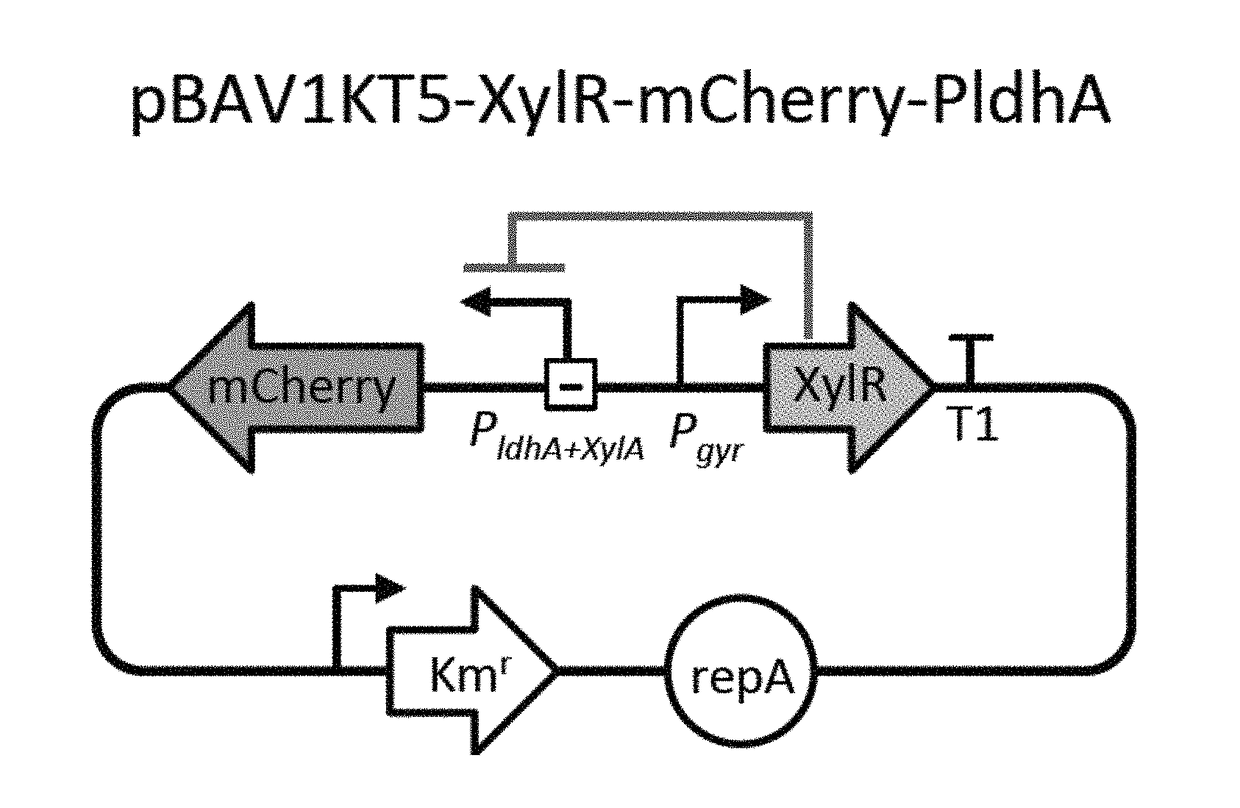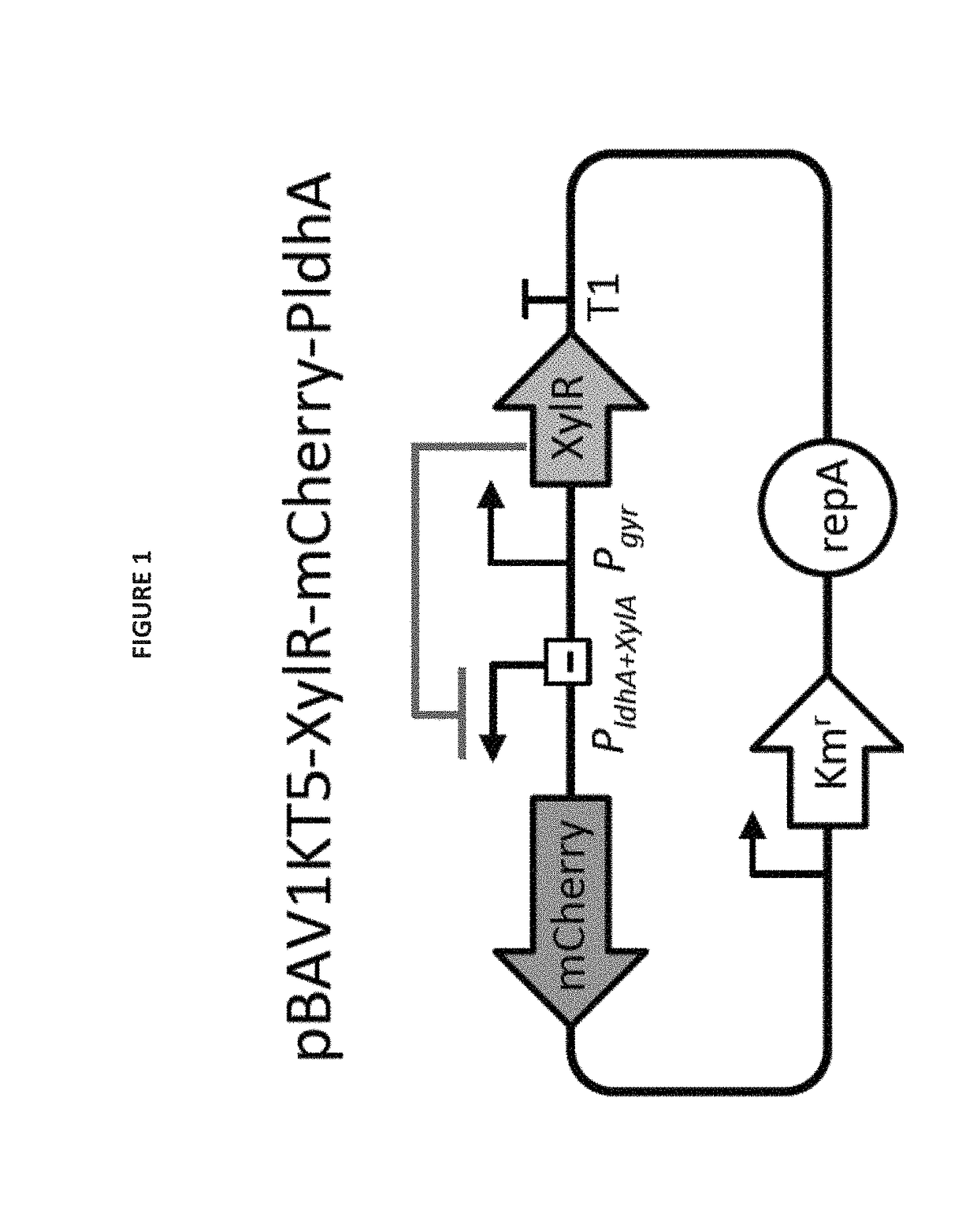Selectively altering microbiota for immune modulation
- Summary
- Abstract
- Description
- Claims
- Application Information
AI Technical Summary
Benefits of technology
Problems solved by technology
Method used
Image
Examples
example 1
Microbiota Bacterial Population Growth Inhibition by Harnessing Wild-Type Endogenous Cas
[0734]1. Material and Methods
[0735]1. 1. Strains
[0736]The following strains were used in the course of this Example and Examples 2 and 3: E. coli MG1655, E. coli TOP10, Streptococcus thermophilus LMD-9 (ATCC BAA-491, Manassas, Va.), Streptococcus thermophilus DSM 20617(T) (DSMZ, Braunschweig, Germany), Lactococcus lactis MG1363 and Streptococcus mutans Clarke 1924 DSM 20523 (DSMZ, Braunschweig, Germany).
[0737]During the course of media selection and testing of the genetic constructs different Streptoccoci strains were used. Streptococcus thermophilus LMD-9 (ATCC BAA-491) and Escherichia coli TOP10 were considered because of their compatible growth requirements. All strains were cultivated in Todd-Hewitt broth (TH) (T1438 Sigma-Aldrich), in aerobic conditions and at 37° C., unless elsewhere indicated. The strains were stored in 25% glycerol at −80° C.
[0738]1. 2. Differential Growth Media
[0739]All ...
example 2
Microbiota Bacterial Population Growth Inhibition in Different Strains
[0782]Example 1 demonstrated specific growth inhibition of Streptococcus thermophilus LMD-9. Here we demonstrate growth inhibition can also be obtained in a second strain: Streptococcus thermophilus DSM 20617. Methods described in Example 1 were, therefore, applied to the latter strain (except that selective media for S.thermophilus DSM 20617 was TH media supplemented with 2.5 g l−1 of 2-phenylethanol (PEA)).
[0783]Streptococcus thermophilus DSM 20617 transformed with the CRISPR array plasmids were incubated for recovery in liquid media for a period of 3 hours at 37° C. that would allow for expression of kanamycin resistance. After a recovery period, cells were plated in different selection media in presence of 1% xylose in order to induce cell death, and without xylose as a control (FIG. 10). It is evident that; (1) by xylose induction the growth of S. thermophilus can be inhibited (around 10-fold for the ‘strong’...
example 3
Bacterial Population Growth Inhibition in a Mixed Consortium of Different Microbiota Species
[0784]We next demonstrated selective growth inhibition of a specific bacterial species in a mixed population of three species. We selected species found in gut microbiota of humans and animals (S thermophilus DSM 20617(T), Lactobacillus lactis and E coli). We included two gram-positive species (the S thermophilus and L lactis) to see if this would affect the ability for selective killing of the former species; furthermore to increase difficulty (and to more closely simulate situations in microbiota) L lactis was chosen as this is a phylogenetically-related species to S thermophilus (as indicated by high 16s ribosomal RNA sequence identity between the two species). The S thermophilus and L lactis are both Firmicutes. Furthermore, to simulate microbiota, a human commensal gut species (E coli) was included.
[0785]1. Materials & Methods
[0786]Methods as set out in Example 1 were used (except that s...
PUM
 Login to View More
Login to View More Abstract
Description
Claims
Application Information
 Login to View More
Login to View More - R&D
- Intellectual Property
- Life Sciences
- Materials
- Tech Scout
- Unparalleled Data Quality
- Higher Quality Content
- 60% Fewer Hallucinations
Browse by: Latest US Patents, China's latest patents, Technical Efficacy Thesaurus, Application Domain, Technology Topic, Popular Technical Reports.
© 2025 PatSnap. All rights reserved.Legal|Privacy policy|Modern Slavery Act Transparency Statement|Sitemap|About US| Contact US: help@patsnap.com



